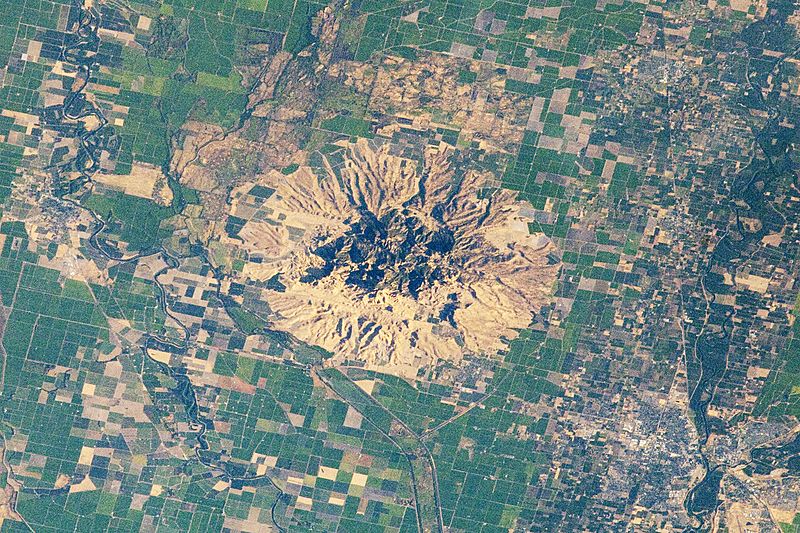Image: Sutter Buttes Bird's eye view

Description: Sometimes called the “smallest mountain range in the world,” the Sutter Buttes rise almost 610 meters (2,000 feet) above the flat agricultural fields of the Great Valley of central California. The Sutter Buttes are remnants of a volcano that was active approximately 1.6 to 1.4 million years ago during the Pleistocene Epoch. The central core of the Buttes is characterized by lava domes—piles of viscous lava that erupted onto the surface and were built higher with each successive layer. Today, these lava domes form the high central hills of the Buttes; shadows cast by the hills are visible at image center. Surrounding the core is an apron of fragmental material created by occasional eruptions of the lava domes. This apron extends roughly 18 kilometers east-to-west and 16 kilometers north-to-south (11 by 10 miles). The volcanic material was transported outwards from the central core by volcanic gas-driven pyroclastic flows or by cooler, water-driven lahars. Later stream erosion of the debris apron is evident from the drainage pattern surrounding the central core. A third geomorphic region of valleys, known as the “moat,” lies between the core and the debris apron, and was formed by erosion of older, exposed sedimentary rocks that underlie the volcanic rocks.
Title: Sutter Buttes Bird's eye view
Credit: http://earthobservatory.nasa.gov/IOTD/view.php?id=79049
Author: Expedition 32 crew/NASA
Permission: Public Domain Public domainPublic domainfalsefalse This file is in the public domain in the United States because it was solely created by NASA. NASA copyright policy states that "NASA material is not protected by copyright unless noted". (See Template:PD-USGov, NASA copyright policy page or JPL Image Use Policy.) Warnings: Use of NASA logos, insignia and emblems is restricted per U.S. law 14 CFR 1221. The NASA website hosts a large number of images from the Soviet/Russian space agency, and other non-American space agencies. These are not necessarily in the public domain. Materials based on Hubble Space Telescope data may be copyrighted if they are not explicitly produced by the STScI.[1] See also Template:PD-Hubble and Template:Cc-Hubble. The SOHO (ESA & NASA) joint project implies that all materials created by its probe are copyrighted and require permission for commercial non-educational use. [2] Images featured on the Astronomy Picture of the Day (APOD) web site may be copyrighted. [3] The National Space Science Data Center (NSSDC) site has been known to host copyrighted content. Its photo gallery FAQ states that all of the images in the photo gallery are in the public domain "Unless otherwise noted."
Usage Terms: Public domain
License: Public domain
Attribution Required?: No
Image usage
The following page links to this image:

